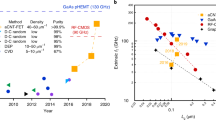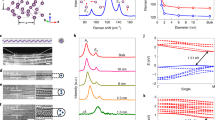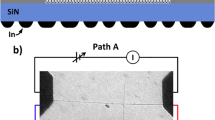Abstract
The development of next-generation wireless communication technology requires integrated radiofrequency devices capable of operating at frequencies greater than 90 GHz. Carbon nanotube field-effect transistors are promising for such applications, but key performance metrics, including operating frequency, at present fall below theoretical predictions. Here we report radiofrequency transistors based on high-purity carbon nanotube arrays that are fabricated using a double-dispersion sorting and binary liquid interface aligning process. The nanotube arrays exhibit a density of approximately 120 nanotubes per micrometre, a maximum carrier mobility of 1,580 cm2 V−1 s−1 and a saturation velocity of up to 3.0 × 107 cm s−1. The resulting field-effect transistors offer high d.c. performance (on-state current of 1.92 mA µm−1 and peak transconductance of 1.40 mS μm−1 at a bias of −0.9 V) for operation at millimetre-wave and terahertz frequencies. Transistors with a 50 nm gate length show current-gain and power-gain cutoff frequencies of up to 540 and 306 GHz, respectively, and radiofrequency amplifiers can exhibit a high power gain (23.2 dB) and inherent linearity (31.2 dBm output power of the third-order intercept point) in the K-band (18 GHz).
This is a preview of subscription content, access via your institution
Access options
Access Nature and 54 other Nature Portfolio journals
Get Nature+, our best-value online-access subscription
$29.99 / 30 days
cancel any time
Subscribe to this journal
Receive 12 digital issues and online access to articles
$119.00 per year
only $9.92 per issue
Buy this article
- Purchase on Springer Link
- Instant access to full article PDF
Prices may be subject to local taxes which are calculated during checkout





Similar content being viewed by others
Data availability
The data that support the plots within this paper and other findings of this study are available from the corresponding authors upon reasonable request.
References
Rüddenklau, U. et al. mmWave semiconductor industry technologies: status and evolution. ETSI White Paper 15 (2018).
Dang, S., Amin, O., Shihada, B. & Alouini, M.-S. What should 6G be? Nat. Electron. 3, 20–29 (2020).
Schwierz, F. & Liou, J. J. J. S.-S. E. RF transistors: recent developments and roadmap toward terahertz applications. Solid-State Electron. 51, 1079–1091 (2007).
Publications of International Technology Roadmap for Semiconductors (ITRS 2.0, 2015) by Semiconductor Industry Association. https://www.semiconductors.org/resources/2015-international-technology-roadmap-for-semiconductors-itrs/ (2015).
Saleh, R. et al. System-on-chip: reuse and integration. Proc. IEEE 94, 1050–1069 (2006).
Burke, P. J. AC performance of nanoelectronics: towards a ballistic THz nanotube transistor. Solid-State Electron. 48, 1981–1986 (2004).
Guo, J., Hasan, S., Javey, A., Bosman, G. & Lundstrom, M. Assessment of high-frequency performance potential of carbon nanotube transistors. IEEE Trans. Nanotechnol. 4, 715–721 (2005).
Koswatta, S. O., Valdes-Garcia, A., Steiner, M. B., Lin, Y.-M. & Avouris, P. Ultimate RF performance potential of carbon electronics. IEEE Trans. Microw. Theory Techn. 59, 2739–2750 (2011).
Zhong, D., Zhang, Z. & Peng, L.-M. Carbon nanotube radio-frequency electronics. Nanotechnology 28, 212001 (2017).
Rutherglen, C., Jain, D. & Burke, P. Nanotube electronics for radiofrequency applications. Nat. Nanotechnol. 4, 811–819 (2009).
Baumgardner, J. E. et al. Inherent linearity in carbon nanotube field-effect transistors. Appl. Phys. Lett. 91, 052107 (2007).
Wang, C. et al. Radio frequency and linearity performance of transistors using high-purity semiconducting carbon nanotubes. ACS Nano 5, 4169–4176 (2011).
Liu, L. et al. Aligned, high-density semiconducting carbon nanotube arrays for high-performance electronics. Science 368, 850–856 (2020).
Cao, Q., Tersoff, J., Farmer, D. B., Zhu, Y. & Han, S. J. Carbon nanotube transistors scaled to a 40-nanometer footprint. Science 356, 1369–1372 (2017).
Qiu, C. et al. Scaling carbon nanotube complementary transistors to 5-nm gate lengths. Science 355, 271–276 (2017).
Mothes, S., Claus, M. & Schröter, M. Toward linearity in Schottky barrier CNTFETs. IEEE Trans. Nanotechnol. 14, 372–378 (2015).
Maas, S. Linearity and dynamic range of carbon nanotube field-effect transistors. 2017 IEEE MTT-S International Microwave Symposium (IMS), 87–90 (2017).
Peng, L.-M., Zhang, Z. & Qiu, C. Carbon nanotube digital electronics. Nat. Electron. 2, 499–505 (2019).
Zhong, D. et al. Carbon nanotube film-based radio frequency transistors with maximum oscillation frequency above 100 GHz. ACS Appl. Mater. Interfaces 11, 42496–42503 (2019).
Rutherglen, C. et al. Wafer-scalable, aligned carbon nanotube transistors operating at frequencies of over 100 GHz. Nature. Nat. Electron. 2, 530–539 (2019).
Zhong, D. et al. Gigahertz integrated circuits based on carbon nanotube films. Nat. Electron. 1, 40–45 (2018).
Kocabas, C. et al. High-frequency performance of submicrometer transistors that use aligned arrays of single-walled carbon nanotubes. Nano Lett. 9, 1937–1943 (2009).
Che, Y., Lin, Y.-C., Kim, P. & Zhou, C. T-gate aligned nanotube radio frequency transistors and circuits with superior performance. ACS nano 7, 4343–4350 (2013).
Cao, Y. et al. Radio frequency transistors using aligned semiconducting carbon nanotubes with current-gain cutoff frequency and maximum oscillation frequency simultaneously greater than 70 GHz. ACS Nano 10, 6782–6790 (2016).
Joo, Y., Brady, G. J., Arnold, M. S. & Gopalan, P. Dose-controlled, floating evaporative self-assembly and alignment of semiconducting carbon nanotubes from organic solvents. Langmuir 30, 3460–3466 (2014).
Marsh, P. F. et al. Solving the linearity and power conundrum: carbon nanotube RF amplifiers. Microw. J. 62, 22–32 (2019).
Cao, Q. et al. Arrays of single-walled carbon nanotubes with full surface coverage for high-performance electronics. Nat. Nanotechnol. 8, 180–186 (2013).
Franklin, A. D. Electronics: the road to carbon nanotube transistors. Nature 498, 443–444 (2013).
Ding, J. et al. Enrichment of large-diameter semiconducting SWCNTs by polyfluorene extraction for high network density thin film transistors. Nanoscale 6, 2328–2339 (2014).
Gomulya, W. et al. Semiconducting single-walled carbon nanotubes on demand by polymer wrapping. Adv. Mater. 25, 2948–2956 (2013).
Gu, J. et al. Solution-processable high-purity semiconducting SWCNTs for large-area fabrication of high-performance thin-film transistors. Small 12, 4993–4999 (2016).
Shastry, T. A. et al. Large-area, electronically monodisperse, aligned single-walled carbon nanotube thin films fabricated by evaporation-driven self-assembly. Small 9, 45–51 (2013).
Hong, S. W., Banks, T. & Rogers, J. A. Improved density in aligned arrays of single-walled carbon nanotubes by sequential chemical vapor deposition on quartz. Adv. Mater. 22, 1826–1830 (2010).
Si, J. et al. Scalable preparation of high-density semiconducting carbon nanotube arrays for high-performance field-effect transistors. ACS Nano 12, 627–634 (2018).
Brady, G. J. et al. Polyfluorene-sorted, carbon nanotube array field-effect transistors with increased current density and high on/off ratio. ACS Nano 8, 11614–11621 (2014).
Shekhar, S., Stokes, P. & Khondaker, S. I. Ultrahigh density alignment of carbon nanotube arrays by dielectrophoresis. ACS Nano 5, 1739–1746 (2011).
Ma, Z. et al. Improving the Performance and uniformity of carbon-nanotube-network-based photodiodes via yttrium oxide coating and decoating. ACS Appl. Mater. Interfaces 11, 11736–11742 (2019).
Shulaker, M. M. et al. Three-dimensional integration of nanotechnologies for computing and data storage on a single chip. Nature 547, 74–78 (2017).
Yu, C. et al. Quasi-free-standing bilayer epitaxial graphene field-effect transistors on 4H-SiC (0001) substrates. Appl. Phys. Lett. 108, 013102 (2016).
Wu, Y. et al. 200 GHz maximum oscillation frequency in CVD graphene radio frequency transistors. ACS Appl. Mater. Interfaces 8, 25645–25649 (2016).
Yu, C. et al. Improvement of the frequency characteristics of graphene field-effect transistors on SiC substrate. IEEE Electron Device Lett. 38, 1339–1342 (2017).
Brady, G. J. et al. Quasi-ballistic carbon nanotube array transistors with current density exceeding Si and GaAs. Sci. Adv. 2, e1601240 (2016).
Xu, L., Qiu, C., Zhao, C., Zhang, Z. & Peng, L.-M. Insight Into ballisticity of room-temperature carrier transport in carbon nanotube field-effect transistors. IEEE Trans. Electron Devices 66, 3535–3540 (2019).
Lee, C.-S., Pop, E., Franklin, A. D., Haensch, W. & Wong, H.-S. A compact virtual-source model for carbon nanotube FETs in the sub-10-nm regime—part I: intrinsic elements. IEEE Trans. Electron Devices 62, 3061–3069 (2015).
Shulaker, M. M. et al. High-performance carbon nanotube field-effect transistors. 2014 IEEE International Electron Devices Meeting 33.6.1–33.6.4 (2014).
Tyagi, S. et al. A 130 nm generation logic technology featuring 70 nm transistors, dual Vt transistors and 6 layers of Cu interconnects. International Electron Devices Meeting 2000. Technical Digest 567–570 (2000).
Yang, S. et al. A high performance 180 nm generation logic technology. International Electron Devices Meeting 1998. Technical Digest 197–200 (1998).
Bohr, M. et al. A high performance 0.25 /spl mu/m logic technology optimized for 1.8 V operation. International Electron Devices Meeting. Technical Digest 847–850 (1996).
Bohr, M. et al. A high performance 0.35 /spl mu/m logic technology for 3.3 V and 2.5 V operation. Proceedings of 1994 IEEE International Electron Devices Meeting 273–276 (1994).
Gummel, H. K. On the definition of the cutoff frequency fT. Proc. IEEE 57, 2159 (1969).
Cheng, R. et al. High-frequency self-aligned graphene transistors with transferred gate stacks. Proc. Natl Acad. Sci. USA 109, 11588–11592 (2012).
Steiner, M. et al. High-frequency performance of scaled carbon nanotube array field-effect transistors. Appl. Phys. Lett. 101, 053123 (2012).
Zota, C., Lindelöw, F., Wernersson, L.-E. & Lind, E. High-frequency InGaAs tri-gate MOSFETs with fmax of 400 GHz. Electron. Lett. 52, 1869–1871 (2016).
Lee, S. et al. Record RF performance of 45-nm SOI CMOS technology. IEEE International Electron Devices Meeting 255–258 (2007).
Lee, S. et al. SOI CMOS technology with 360GHz fT NFET, 260GHz fT PFET, and record circuit performance for millimeter-wave digital and analog system-on-chip applications. IEEE Symposium on VLSI Technology 54–55 (2007).
Siegel, P. H. Terahertz technology. IEEE Trans. Microw. Theory Techn. 50, 910–928 (2002).
Liou, J. J. Modern Microwave Transistors: Theory, Design, and Applications (J. Wiley, 2003).
RF Gain Block Amplifier (Product No. TRF37C73) https://www.ti.com/product/TRF37C73/ (Texas Instruments, 2014).
InGaP Broadband Amplifier (Product No. MMG38151) https://www.nxp.com.cn/products/radio-frequency/rf-amplifiers-low-medium-power/wideband-amplifiers/general-purpose-amplifiers/0-6000-mhz-bts-driver:MMG38151B/ (NXP, 2014).
RF/IF Gain Block Amplifier (Product No. ADL5610) https://www.analog.com/cn/products/adl5610.html#product-overview/ (ADI, 2013).
Linten, D. et al. A 5-GHz fully integrated ESD-protected low-noise amplifier in 90-nm RF CMOS. IEEE J. Solid-State Circuits 40, 1434–1442 (2005).
Javey, A., Guo, J., Wang, Q., Lundstrom, M. & Dai, H. Ballistic carbon nanotube field-effect transistors. Nature 424, 654–657 (2003).
Franklin, A. D. & Chen, Z. Length scaling of carbon nanotube transistors. Nat. Nanotechnol. 5, 858–862 (2010).
Acknowledgements
We thank C. Jin (Zhejiang University) and S. Ding (Xiangtan University) for TEM technique support, and H. Liu and B. Sun (Institute of Microelectronics of the Chinese Academy of Sciences) for S-parameter, single-tone and two-tone measurement support. This work is supported by the National Key Research & Development Program (grant no. 2016YFA0201901), the National Science Foundation of China (grant nos. 61888102 and 61671020) and the Beijing Municipal Science and Technology Commission (grant no. Z181100004418011).
Author information
Authors and Affiliations
Contributions
Z.Z. and L.-M.P. proposed and supervised the project. H.S. and D.Z. performed device fabrication and d.c. measurements. D.Z. and H.S. designed and optimized the three-dimensional geometry of G/S/D electrodes and gate dielectric thickness. D.Z. and H.S. designed the multi-finger RF device structure. J.H. and H.W. produced the aligned CNT arrays. H.S., L.L., D.Z. and J.H. characterized the CNT materials. H.S. and L.L. performed the polarized Raman spectroscopy characterization. L.X. performed the mobility and saturation velocity simulations using a virtual source model. D.Z. and H.S. performed the small-signal model simulations. H.S., D.Z., P.S. and L.F. performed the S-parameter measurements. H.S., D.Z., L.D. and J.Z. performed the single-tone and two-tone tests. H.S., L.D., D.Z., Z.Z. and L.-M.P. analysed the data. H.S., L.D., Z.Z. and L.-M.P. co-wrote the manuscript. All the authors discussed the results and commented on the manuscript.
Corresponding authors
Ethics declarations
Competing interests
The authors declare no competing interests.
Additional information
Peer review information Nature Electronics thanks Qingwen Li and the other, anonymous, reviewer(s) for their contribution to the peer review of this work.
Publisher’s note Springer Nature remains neutral with regard to jurisdictional claims in published maps and institutional affiliations.
Supplementary information
Supplementary Information
Supplementary Figs. 1–17 and Tables 1–8.
Rights and permissions
About this article
Cite this article
Shi, H., Ding, L., Zhong, D. et al. Radiofrequency transistors based on aligned carbon nanotube arrays. Nat Electron 4, 405–415 (2021). https://doi.org/10.1038/s41928-021-00594-w
Received:
Accepted:
Published:
Issue Date:
DOI: https://doi.org/10.1038/s41928-021-00594-w
This article is cited by
-
Chirality engineering for carbon nanotube electronics
Nature Reviews Electrical Engineering (2024)
-
Emerging memory electronics for non-volatile radiofrequency switching technologies
Nature Reviews Electrical Engineering (2024)
-
Scaling aligned carbon nanotube transistors to a sub-10 nm node
Nature Electronics (2023)
-
Length-dependent alignment of large-area semiconducting carbon nanotubes self-assembly on a liquid-liquid interface
Nano Research (2023)
-
Temperature-dependent electrical properties of schottky barrier diodes based on carbon nanotube arrays
Journal of Materials Science: Materials in Electronics (2023)



